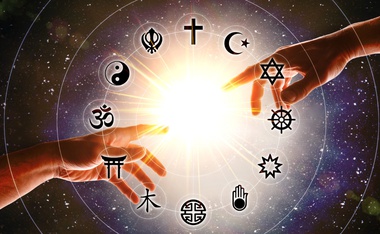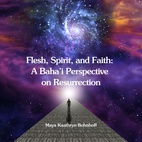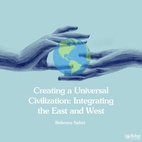The views expressed in our content reflect individual perspectives and do not represent the authoritative views of the Baha'i Faith.
What’s in a name? That immortal Shakespearean question asks us to consider the true meaning of identity, just as this quotation from Genesis 17 recounts God bestowing Abraham’s new name:
Neither shall thy name any more be called Abram, but thy name shall be Abraham; for a father of many nations have I made thee. And I will make thee exceeding fruitful, and I will make nations of thee, and kings shall come out of thee. And I will establish my covenant between me and thee and thy seed after thee in their generations for an everlasting covenant, to be a God unto thee, and to thy seed after thee.
RELATED: 4 Ways to Understand the Relationship of the Prophets
We frequently employ titles to designate profession, rank, or status. Naming is one of the initial powers that language itself bestows upon humankind. Therefore if we wish to discover the essential nature of the prophets, messengers, and manifestations of God, we should obviously begin with what their names and titles say about themselves.
These statements, together with what accepted authoritative scripture says about them, should establish a decent starting point in our attempt to approach what is possibly the single most critical question one can pose: What is the exact nature of these mysterious beings?
The Symbolic Titles of the Manifestations
The messengers and manifestations often assume a symbolic title once they announce their station as emissaries of God. For example, it is fairly common knowledge that the “Buddha” (the “awakened one” or the “enlightened one”) is a title adopted by Siddhartha at age thirty-five after he had meditated for forty-nine days and had arrived at an insight about how the single cause of human suffering is ignorance. According to Buddhist tradition, he also began to reveal a solution to this problem and to articulate guidance about spiritual development. He discussed what has become known as the path of moderation, a middle path between the extremes of self-indulgence and self-mortification.
In the Old Testament, some information is provided about the names of what are referred to as the “Antediluvian Patriarchs,” Adam and Noah, who are considered manifestations by Islam and by the Baha’i Faith. The information about their lives is so scant and mythically charged that we have no exact sense of the point of transformation in which their names attain their symbolic value. For example, one etymology of the word Adam is the masculine form of the word adamah, meaning “ground” or “earth,” an appropriate appellation for one who symbolizes a cognitive human being fashioned by the Creator from water and clay.
The manifestation Noah, according to the account in Genesis, was named by his father Lamech to symbolize the fact that Noah would introduce agriculture to the people; therefore he named his son “Noah,” meaning “rest” in Hebrew to signify that teaching people this essential skill would turn them from nomadic hunter-gathers into citizens of settled communities.
Abraham as a Point of Beginning
With Abraham we begin to discern a religious history in the Abrahamic line of manifestations sufficiently complete in both biblical and Qur’anic sources to discover a revelation in which the name or title of the manifestation is related explicitly to the revelation of a covenant with God and to an explicit mission associated with that covenant.
It is important to note, however, that from a Baha’i perspective, the only totally reliable scriptural texts from any manifestations are the Qur’an, which was dictated by Muhammad, the writings of the Bab, and the writings of Baha’u’llah. Baha’is accept the New Testament as containing valuable and probably reliable information about many of the things Christ said, but many of the Biblical tales cannot be taken literally, because they purposely are told as allegories, parables or symbolic myths. Abdu’l-Baha gives this explanation: “What is intended by the creation of heaven and earth in six days is a spiritual creation and a divine day, as prior to the creation of this heaven and earth there were no days and nights.”
In his book Some Answered Questions, Abdu’l-Baha discusses the use of these metaphorical and symbolic statements in the holy books by specifically referring to one of the biblical prophecies of the second coming of Christ, which, he explains:
… follows a similar pattern. All the signs and conditions that have been indicated have inner meanings and are not to be taken literally. For otherwise it is said, among other things, that the stars will fall upon the earth. Yet, the stars are endless and innumerable, and modern mathematicians have established and proven that the mass of the sun is approximately one and a half million times greater than that of the earth, and that each one of the fixed stars is a thousand times larger than the sun. If those stars were to fall upon the surface of the earth, how could there be room for them? It would be as though a thousand million mountains as mighty as the Himalayas were to fall upon a grain of mustard seed. Such a thing is, by reason and by science (and indeed as a matter of simple common sense), utterly impossible. …
It is therefore clear and evident that these signs have inner meanings and should not be taken literally.
Also, as contemporary scholarship now acknowledges, the four gospels were written after Christ’s crucifixion as recorded from notes taken by largely unknown or historically unauthenticated sources. Baha’u’llah wrote: “The Four Gospels were written after Him [Christ]. John, Luke, Mark and Matthew – these four wrote after Christ what they remembered of His utterances.”
Contemporary scholarship also dates Abraham as having lived somewhere between 2000–1500 BCE. Regardless of the accuracy of the dating of his religious dispensation, according to both biblical and Qur’anic accounts, the appearance of Abraham is portrayed as a milestone in religious history. Part of his station is indicated by the biblical account of the changing of his name or title from “Abram,” which means “revered father,” to “Abraham,” meaning “father of many” or “progenitor of many peoples or nations.” This change in title resulted from Abraham’s covenant with God. Biblically, Abraham represents the prophet who establishes for all time the monotheistic doctrine associated with the Abrahamic line of prophets.
The Qur’an’s allusions to the life and importance of Abraham are markedly different from the Biblical accounts. Instead of portraying “Abraham” as agreeing to sacrifice His son “Isaac” as depicted in the biblical account, the Qur’an asserts that it was “Ibrahim’s” first born son “Ishmael.” Likewise, the Bible focuses on Isaac, who becomes the progenitor of the Hebraic peoples and the manifestations Moses and Christ – whereas the Qur’an focuses on Ishmael as the progenitor of the Arabic nation and the Arabic line of manifestations Hud, Salih, and Muhammad.
RELATED: Are the Major Faiths Actually One Faith?
Regardless of the differing names of these prophets and manifestations, however, Baha’u’llah clearly taught that they all represent “one light and one spirit:”
If thou be of the inmates of this city within the ocean of divine unity, thou wilt view all the Prophets and Messengers of God as one soul and one body, as one light and one spirit, in such wise that the first among them would be last and the last would be first. For they have all arisen to proclaim His Cause and have established the laws of divine wisdom. They are, one and all, the Manifestations of His Self, the Repositories of His might, the Treasuries of His Revelation, the Dawning-Places of His splendour and the Daysprings of His light. Through them are manifested the signs of sanctity in the realities of all things and the tokens of oneness in the essences of all beings. Through them are revealed the elements of glorification in the heavenly realities and the exponents of praise in the eternal essences. From them hath all creation proceeded and unto them shall return all that hath been mentioned. And since in their inmost Beings they are the same Luminaries and the self-same Mysteries, thou shouldst view their outward conditions in the same light, that thou mayest recognize them all as one Being, nay, find them united in their words, speech, and utterance. …
It is therefore established that all names and attributes return unto these sublime and sanctified Luminaries. Indeed, all names are to be found in their names, and all attributes can be seen in their attributes. Viewed in this light, if thou wert to call them by all the names of God, this would be true, as all these names are one and the same as their own Being.

















Comments
Sign in or create an account
Continue with Googleor